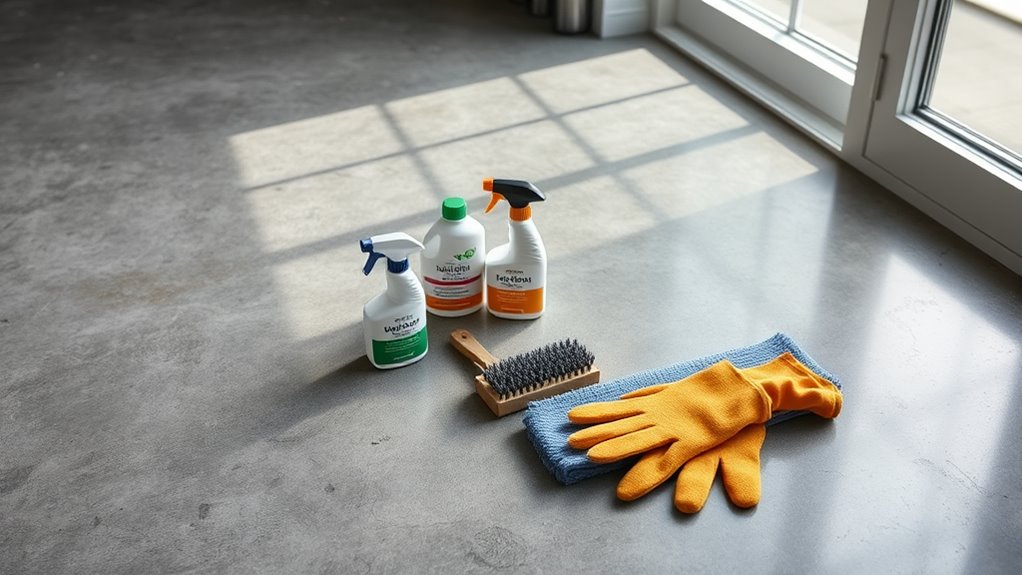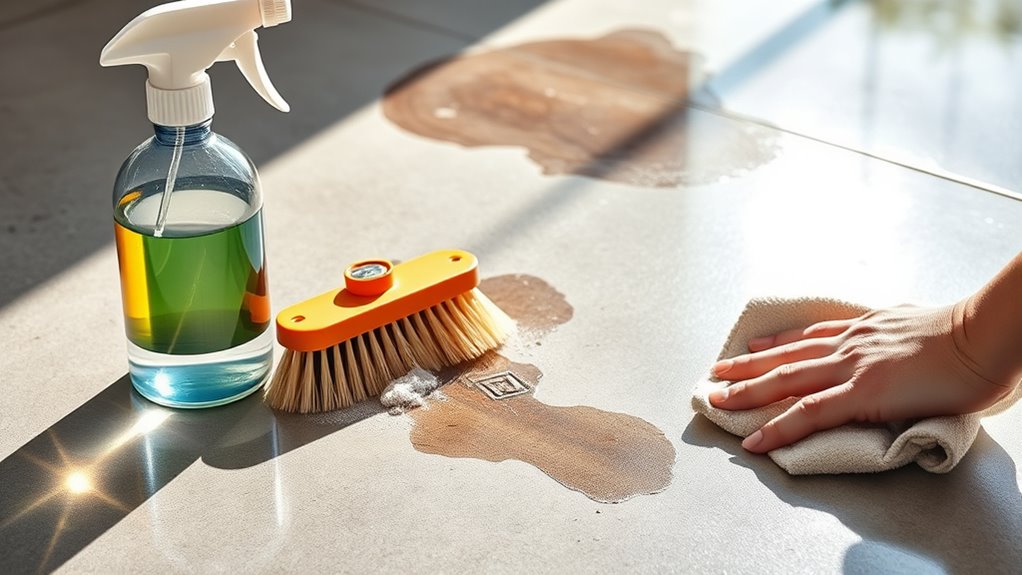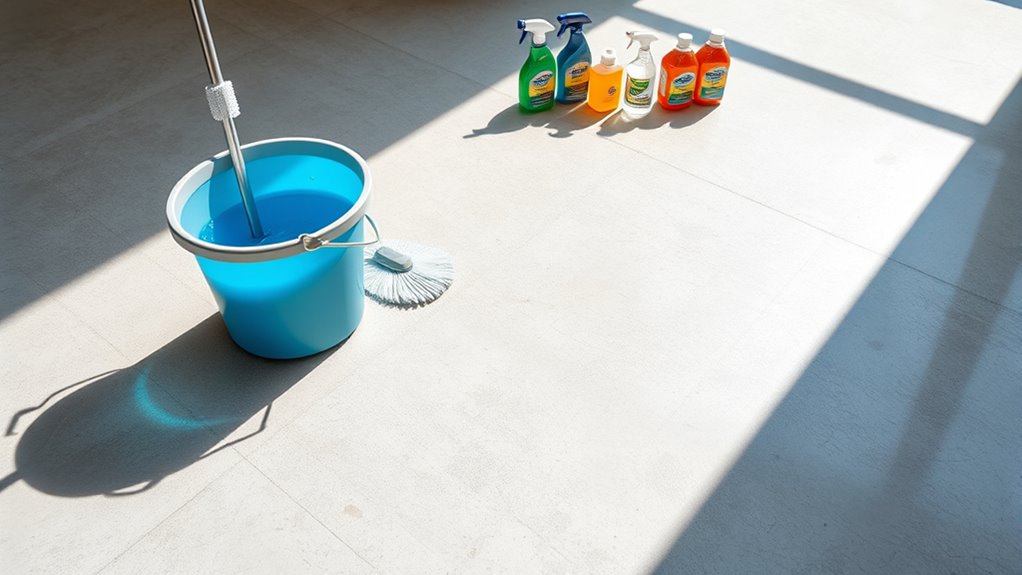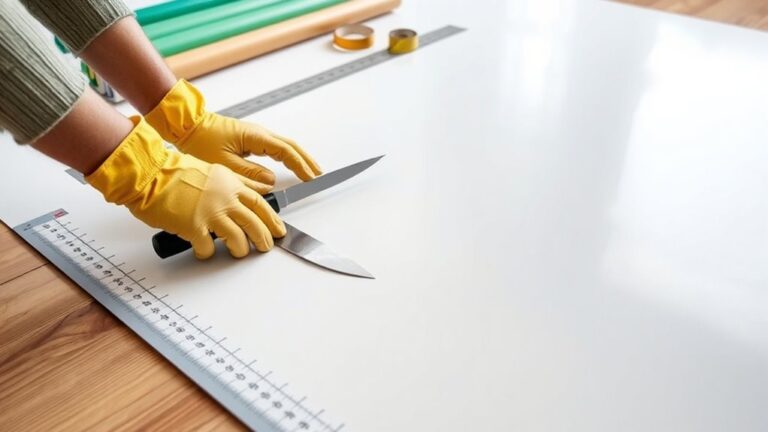You’ll want to start by identifying your concrete type—plain, polished, or sealed—to choose the right cleaning approach. Use a stiff-bristle broom to remove debris, then mop with a pH-neutral cleaner to protect the surface. For stains, apply targeted treatments like baking soda or diluted vinegar, avoiding harsh chemicals. Regular sealing and prompt spill cleanup help maintain durability. Understanding preparation, stain removal, and eco-friendly options guarantees your floors look great longer; more expert tips await.
Understanding Different Types of Concrete Floors

There are three main types of concrete floors you’ll encounter: plain, polished, and sealed. Each has unique concrete variations and types of finishes that affect cleaning methods. Plain concrete is porous and uncoated, making it prone to stains but easy to restore with simple cleaning. Polished concrete boasts a smooth, glossy finish achieved through grinding, which resists dirt and requires less maintenance. Sealed concrete floors feature protective coatings like acrylic or epoxy, safeguarding against moisture and spills; these finishes demand specific cleaning products to maintain their integrity. Understanding these distinctions empowers you to select the right approach without constraints. By recognizing how each finish interacts with dirt and cleaning agents, you’ll enjoy freedom in maintaining your concrete floor’s appearance efficiently and effectively.
Essential Tools and Supplies for Cleaning Concrete
To clean concrete floors effectively, you’ll need a specific set of tools and supplies tailored to the sol‘s type and finish. Having the right cleaning tools guarantees you can tackle dirt, stains, and grime without damaging the surface. Essential supplies help you maintain both smooth and textured concrete with precision.
Effective concrete floor cleaning requires the right tools and supplies to protect and maintain every surface type.
Here are the cleaning tools and essential supplies you’ll want:
- Stiff-bristle broom or push broom for loosening debris
- Industrial-grade mop or microfiber mop for thorough cleaning
- pH-neutral concrete cleaner to protect the floor’s finish
- Stiff scrub brush for stubborn stains and textured surfaces
- Wet/dry vacuum to efficiently remove water and dirt
Equipping yourself with these will give you the freedom to keep your concrete floors spotless and durable.
Preparing Your Concrete Floor for Cleaning

Before you start cleaning, you’ll want to clear the concrete floor of any loose debris and dust using a stiff-bristle broom or a push broom. Next, conduct a thorough floor assessment to identify stains, cracks, or areas with heavy buildup. This step helps you determine the appropriate cleaning method and products. For effective surface preparation, make certain the floor is completely dry and free of oil or grease; you might need a degreaser for stubborn spots. Also, check for any repairs needed, as cracks or damaged sections can affect cleaning results. Proper surface preparation guarantees your cleaning efforts penetrate deeply and evenly, giving you the freedom to maintain a pristine, durable concrete floor with confidence.
Best Products for Everyday Concrete Floor Maintenance
You’ll want to choose pH-neutral cleaners to avoid damaging your concrete’s surface while maintaining its integrity. Applying a quality sealer will protect your floor from stains and wear, extending its lifespan. Regular use of protectants helps maintain the floor’s appearance and makes future cleaning easier.
Ph-Neutral Cleaners
A pH-neutral cleaner is essential for maintaining concrete floors without damaging their surface or sealer. Choosing the right ph neutral options provides numerous ph neutral benefits, including preserving the floor’s integrity and preventing discoloration. When you opt for these cleaners, you get effective dirt removal without harsh chemicals that strip protective layers. Consider these key advantages of pH-neutral cleaners:
- Safe for sealed and polished concrete
- Prevents etching and surface damage
- Environmentally friendly and biodegradable
- Suitable for regular, everyday cleaning
- Compatible with most cleaning tools and equipment
Sealers and Protectants
Although regular cleaning is crucial, applying the right sealers and protectants is what truly preserves your concrete floor’s durability and appearance over time. For effective sealer application, start by thoroughly cleaning and drying the surface to guarantee ideal adhesion. Choose a penetrating sealer for outdoor floors to repel moisture without altering texture, or a topical sealer indoors for added gloss and stain resistance. Surface protectants like acrylics or urethanes create a robust barrier against wear and chemicals, extending your floor’s lifespan. Apply sealers evenly using a roller or sprayer, following manufacturer guidelines closely for curing times. With proper sealer application and quality surface protectants, you maintain not just the floor’s strength but also the freedom to enjoy a low-maintenance, attractive concrete surface every day.
Techniques for Removing Stubborn Stains

When tackling stubborn stains on your concrete floor, start by identifying whether the mark is oil-based, rust, or organic. Choosing the right cleaning solution depends on this classification, as each stain type responds best to specific agents. From applying poultices to using scrub brushes, precise techniques will guarantee effective removal without damaging the surface.
Identifying Stain Types
How can you effectively tackle stubborn stains on concrete floors without knowing their origin? Identifying the stain type is essential before choosing your cleaning approach. Different stains demand specific treatments.
Here are common concrete stains you should recognize:
- Taches d'huile: Dark, greasy spots from vehicle fluids or cooking oils.
- Rust marks: Reddish-brown discolorations caused by metal oxidation.
- Paint spills: Dried, colorful patches often with raised texture.
- Food debris and mold growth: Organic stains that may appear dark or greenish, often damp.
- Tire tracks: Black streaks from rubber abrasion.
Effective Cleaning Solutions
Three key cleaning solutions can tackle most stubborn stains on concrete floors effectively. First, a mixture of baking soda and water creates a mild abrasive paste, perfect for breaking down grime without harsh chemicals. Second, hydrogen peroxide offers a sustainable option that penetrates stains and disinfects simultaneously, ideal if you’re wary of traditional cleaners. Third, a diluted solution of white vinegar counters alkaline stains and balances pH, dispelling common cleaning myths that stronger acids are always better. Avoid overusing bleach, as it can damage concrete and harm the environment. By choosing these precise, environmentally friendly methods, you maintain your floor’s integrity while freeing yourself from reliance on toxic products. These solutions empower you to clean efficiently, responsibly, and sustainably.
Stain Removal Techniques
Building on effective cleaning solutions, mastering stain removal techniques allows you to target the toughest marks without compromising your concrete’s surface. Start with accurate stain identification to select the right treatment. Adjust your approach based on your cleaning frequency—frequent cleanings reduce deep-set stains but require gentler methods.
Consider these techniques:
- Use poultices for oil and grease stains to draw out contaminants.
- Apply hydrogen peroxide for organic stains like coffee or wine.
- Treat rust stains with a commercially available rust remover.
- Employ a mild acid solution for mineral deposits, avoiding damage.
- Utilize a stiff brush and detergent for surface dirt embedded over time.
Using Eco-Friendly Solutions on Concrete Surfaces
Although traditional cleaning chemicals can be effective, opting for eco-friendly solutions on concrete surfaces protects both the environment and your health. You can achieve a spotless floor without harsh toxins by choosing products made from natural ingredients like vinegar, baking soda, and castile soap. These components not only break down dirt and grime efficiently but also align with sustainable practices that reduce chemical runoff and waste. When applying, dilute properly and test on a small area to verify no damage occurs. Using biodegradable cleaners supports the ecosystem and offers you peace of mind. By integrating these eco-conscious methods, you maintain your concrete’s integrity while embracing a cleaner, greener lifestyle—empowering you to care for your space with both freedom and responsibility.
Preventative Measures to Keep Concrete Floors Clean
Since concrete floors are durable yet porous, taking preventative measures is essential to maintaining their cleanliness and longevity. You’ll want to adopt preventative cleaning habits that minimize dirt buildup and protect the surface. Start by placing quality floor mats at all entrances to trap debris and moisture before it reaches the floor. Additionally, consider these steps:
Protect your concrete floors by using quality mats and adopting regular cleaning habits to prevent dirt and damage.
- Regularly sweep or vacuum to remove abrasive particles.
- Use sealed mats in high-traffic areas to prevent wear.
- Apply a penetrating sealer to reduce absorption of stains.
- Clean spills immediately to avoid permanent marks.
- Avoid harsh chemicals that degrade the concrete’s finish.
Tips for Maintaining Outdoor Concrete Areas
When maintaining outdoor concrete areas, you’ll need to address unique challenges like exposure to weather, dirt, and plant debris. Start by scheduling regular outdoor maintenance, including sweeping to remove leaves and dirt that can stain or degrade the surface. Pressure washing is essential during seasonal cleaning, especially in spring and fall when debris and grime accumulate. Use a mild detergent mixed with water for stubborn stains, and avoid harsh chemicals that might damage the concrete or surrounding plants. Sealing your concrete annually will protect it from moisture and UV damage, extending its lifespan. Finally, inspect for cracks or chips regularly and repair them promptly to prevent further deterioration. Following these precise steps guarantees your outdoor concrete stays durable and visually appealing year-round.




